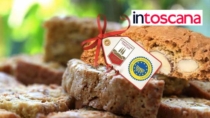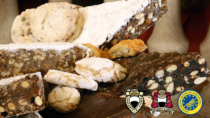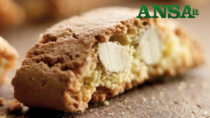Description
Cantuccini Toscani PGI or Cantucci Toscani PGI are biscuits obtained from oven-baked dough made with flour, sweet almonds, sugar, eggs, butter and honey.
Production Area
The production area of Cantucci Toscani PGI is within the entire territory of the Tuscany region.
Production Method
The dough for Cantucci Toscani PGI must be made with wheat flour, whole natural sweet almonds (unblanched), pasteurized hen's eggs and egg yolks, butter and caster, crystallised or granulated sugar; wildflower honey in addition to the sugar and raising agents. The ingredients are mixed to obtain a homogenous dough. It is then shaped into a long sausage-shape, placed on a baking tray and brushed with a mixture of water, egg and sweetening agents to give the product its characteristic golden colour. It is baked in a preheated oven at 100-300° C for a maximum of 40 minutes. The product is then cut either manually or mechanically into diagonal pieces.
Appearance and Flavour
Cantucci Toscani PGI weigh no more than 15 grams and are a maximum of 10 cm long, 3 cm high and 2.8 cm wide. After baking, the biscuits are beige on the inside with slightly irregular holes with form as the dough rises, with a random scattering of unblanched almonds. The outside is golden as a result of baking. They are slightly crunchy, crumbly, and melt in the mouth thanks to the butter.
History
The establishment and diffusion of the art of making pastries and confectionery in Tuscany was motivated by the trading of goods, spices, ideas and recipes that the region's central location made possible over a considerable length of time. The name “cantuccio” or “cantuccino” was used as early as 1691, in the Accademia della Crusca dictionary, which described it as a ""sliced biscuit made with fine flour, sugar and egg whites”. Thanks to the ever-increasing production by the region's many bakeries, Tuscan cantucci also soon became a well-known speciality outside the Tuscany region. Evidence of this can be found in a book entitled Il Pasticciere e confettiere moderno, written by G. Ciocca and published in Milan in 1907. Thanks to their long shelf life, Tuscan cantucci also became popular outside of Italy, and they are now one of the most well-known Italian dry biscuits in the world.
Gastronomy
Cantucci Toscani PGI are best kept in a cool, dry place so that they don’t absorb moisture. This ensures that the product, which is a dry biscuit, maintains its organoleptic properties. In fact, cantucci are traditionally soaked in Vin Santo before being eaten. Serving Cantucci Toscani PGI with Vin Santo, another regional product, has helped establish the product’s reputation as a dessert biscuit, which is also perfect for dipping into other types of liqueur wines. Today, Cantucci Toscani PGI biscuits are now also eaten throughout the day, together with a cup of tea or coffee.
Marketing
The product is marketed as Cantuccini Toscani PGI or Cantucci Toscani PGI. It is sold in cardboard boxes with reclosable lids, or in packets made of other suitable food-grade materials. Producers can also sell the product loose directly to the consumer.
Distinctive Features
The ingredients used to make Cantucci Toscani PGI, especially the sweet unblanched almonds and butter, give the product its typical fragrance and porosity, endorsing its reputation as a typical, rustic biscuit that is also a delicacy.











![[VIDEO] DOP IGP di pani e dolci in grande espansione](https://www.qualivita.it/wp-content/uploads/2025/02/TG5-Dop-economy-210x118.jpg)










